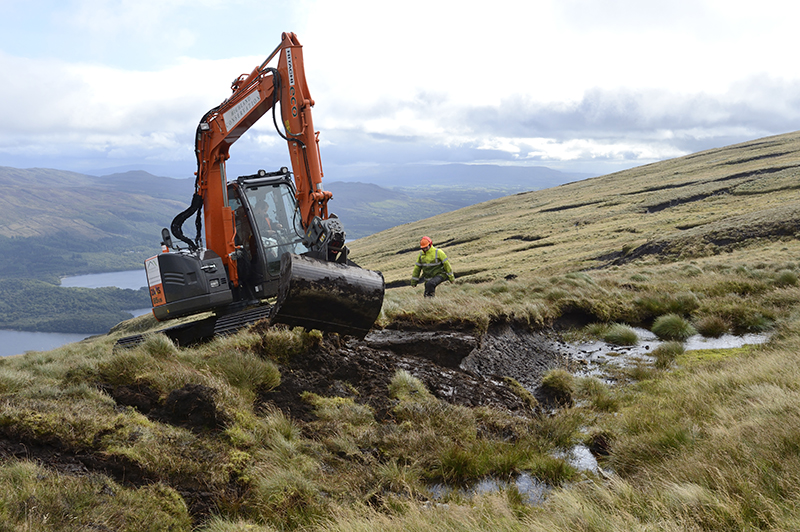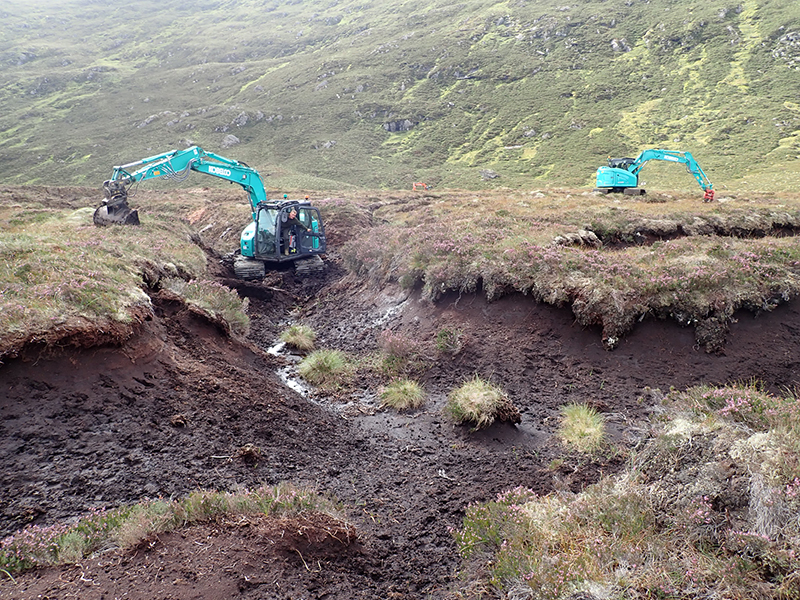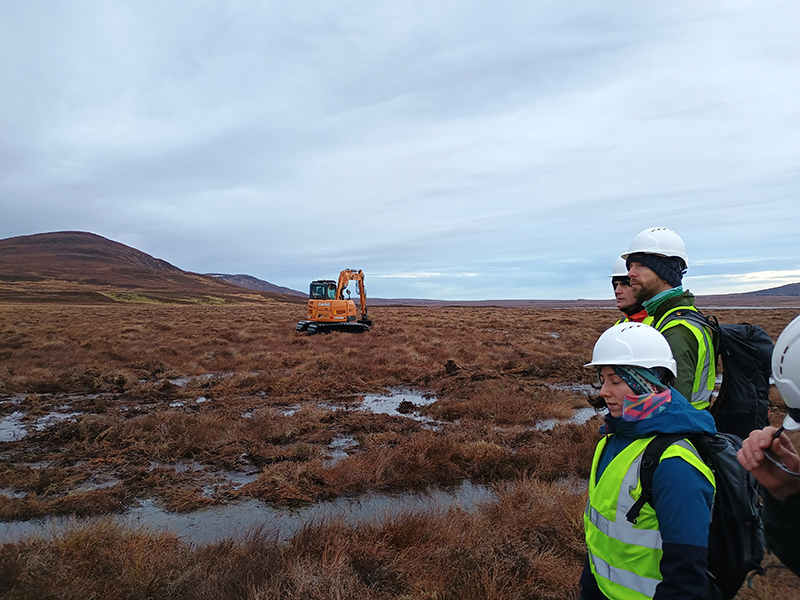SCOTLAND’S plant operators have been praised for their role in the ongoing initiative to restore the nation’s degraded peatlands – with calls going out to encourage more workers to consider careers in the fast-developing sector.
A record 14,860 hectares have been restored across the country over the last year, with many of the techniques used in the process shaped by experienced machinery operators. The Scottish Government has committed to restoring 250,000 hectares of peatland by 2030 as part of the nation’s Climate Change Plan.
Peatland ACTION is a government-funded programme, which facilitates the capital works for putting peatland on the road to recovery. The project has been running since 2012, initially on a relatively small scale, before being ramped up significantly since 2020.
Becky Shaw, Peatland ACTION workforce planning and development manager, told Project Plant back in 2023 about the ‘fundamental’ role plant operators were playing in peatland restoration projects. During a recent catch-up, she spoke of the further progress that has been made since then and emphasised the career opportunities that exist within the burgeoning industry for contractors and operators looking to get involved.
“Scotland has got a significant area of peatland,” Becky explained. “Between 75-80% is degraded. That means it’s either been drained for agricultural use or forestry or perhaps been burnt or heavily grazed.”
Degraded peat emits carbon instead of storing it, as healthy peatlands do.
“Currently the carbon being emitted from these degraded peatlands is around 15% of Scotland’s annual emissions – that’s about as big as the emissions from the transport sector,” Becky added. “Restoring peatland is basically about re-wetting and re-vegetating peatland to stop the loss of carbon, but it also has huge biodiversity benefits and a huge impact on water quality.”
The Scottish Government has pledged £250 million to support the restoration of 250,000ha of peatland by 2030, with an interim target of 110,000 hectares by 2026. Some 90,000 hectares have been restored since 1990.
The work is supporting a significant number of jobs in fields varying from land and project management through to ecological surveying, contracting, and machine operating.
To help expand the talent pool further, Peatland ACTION has launched a new fund to support the development of a skilled workforce. The Peatland Training Fund offers financial support to people looking to develop skills to enter a career in peatlands, or individuals already operating in the industry looking to enhance their capabilities through additional training. The fund is managed by Lantra on behalf of Peatland ACTION partner NatureScot and offers eligible applicants up to 50% funding up to a maximum of £1,000 per course. Eligible training includes excavators and all-terrain vehicles qualifications.
While the opportunities are plentiful, barriers for contractors include staff retention, with Becky highlighting the issue of individuals being trained up only to leave to work in sectors such as forestry, construction, hydro, or wind.
“We’ve done some research recently and staff retention was something that was highlighted prominently. Peatland restoration is not necessarily everybody’s cup of tea. You’ve often got to park your vehicle somewhere and walk quite a way across a moorland to get to your machine. It’s quite well suited to folk who like being outdoors and are quite rural, land-based focused.
“There are also challenges around finance because the scale of the work that needs done in Scotland alone is about 1.8 million hectares. The government has committed a lot of money to the first 250,000, but we’re needing private finance in to help bolster that up. Ensuring a long-term finance perspective is important and we’re working on that pretty hard.
“We probably know what most of the barriers are and we’re working to overcome them all as they come up.”
Despite the challenges, Becky added that she has been ‘hugely’ encouraged by the response from the construction and plant industries to what is trying to be achieved. Many workers have been involved since the beginning, while others have joined more recently.
“There’s some absolutely brilliant work going on from contracting firms,” Becky said. “A lot of the modifications to techniques and developing knowhow has been developed in partnership with people in the contracting sector. There’s been a lot of dialogue and discussion, and a lot of the processes have developed collaboratively with folk who are expert machine operators and folk who are hydrologists and ecologists.
“In fact, when we first developed a workforce development team in Peatland ACTION to say we’d need to upscale the workforce considerably in the next few years to meet these targets, we took a stall at ScotPlant thinking we’d better offer bacon rolls and coffee to get people to come and speak to us. We were queued out the door! We were non-stop talking for the two days because people were actually really interested and wanted to know more about it. Everyone had heard there was a developing area of work there.
“There’s been a huge amount of collaboration because folk designing the restoration are not machine operators. They certainly at the start weren’t as familiar with what machine capabilities were as the people who had lots of experience of using them. There’s been a lot of collaborative input and some really very skilled and knowledgeable people now delivering schemes on the ground, which is great to see. The fact that we’ve increased our area so significantly – I think it was a 42% increase on the year before – is down to having a really willing and committed workforce, and their willingness to work in quite unusual circumstances.”
Typical plant machinery used in peatland restoration includes low ground pressure excavators between eight and 14 tonnes, tracked dumpers, and tiltrotators. The habitat is very sensitive and also very wet in places. Ideal operators are those who are environmentally sensitive and extremely careful with the management of sites.
Anne Murray, from the Peatland ACTION workforce development team, explained one of the factors operators should take into consideration is whether they’ve got machines suitable for working on peat sites, and if they need adaptations.
“One of the challenges we’ve faced in terms of training contractors in the specific restoration techniques is that it actually has to be done on a peat site,” Anne said. “It’s very difficult to replicate the circumstances in a training room or even a general construction site. To help address this we operated a grant programme to encourage contractors to recruit new entrants. We gave them some support for the mentoring that new entrants required.
“What we’re hoping to do next is get experienced machine operators that are new to peatland restoration actually training while the peatland is being restored. They will carry out the restoration as part of their training programme.”
Peatland ACTION is also keen to encourage more trainers to come forward offering relevant training.
At the time of interview, a large number of upcoming projects were due to be announced. This follows around 60 ventures last year. Where projects come forward for funding and the preferred contractor has little or less experience than others, Peatland ACTION will offer mentoring and support.
The Cairngorms National Park has, for a number of years, run a new entrant scheme, which has brought in a number of new contracting businesses. On a restricted tender basis, they have had contracts which firms can only tender for if they haven’t got more than two years’ worth of experience or done more than two projects.
“We did one similarly ourselves this year and also brought in a new contractor,” Becky revealed. “We’ve been building up the contracting workforce in that way. We don’t have any new entrant businesses on a restricted tender basis this year, but we do expect that some of our newer contractors will end up with funded projects so we will be looking to provide mentoring to them in that regard.
“What’s happening at the moment seems to be working quite well because we’ve got this huge and growing output each year. It’s just making sure that we continue to support the sector, that we continue to provide the training, and continue to grow the workforce to meet that challenge.”
• More information can be found at www.nature.scot/peatlandaction













